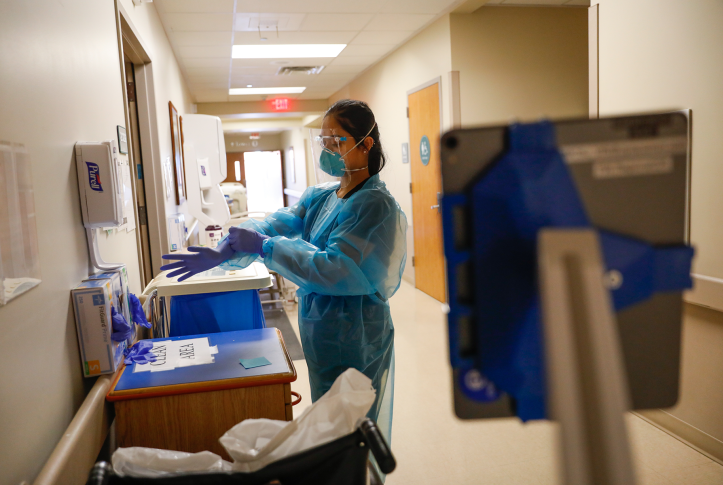According to the World Health Organization, climate change is the biggest threat to human health in the 21st century. And things are only getting worse: the United Nations World Meteorological Organization confirmed that 2023 was the hottest year on record. Climate change affects physical and mental health directly through extreme weather conditions, heat waves, vector-borne diseases, and pandemics; as well as indirectly, as rising temperatures and rain result in uninhabitable areas. The U.N. predicts 200 million climate refugees by 2050. Further, climate change is predicted to cause disturbances in production and supply chains of food and other products, including health care supplies, which can disrupt the delivery of health care. Limited access to raw materials combined with a rising population could cause a surge in market prices. Thus, climate change negatively impacts health, disrupts health care provision, and increases costs.
The health care system — including millions of health care workers — works to support patients and the overall population, but, at the same time, the health care sector has a high climate footprint and thereby compromises health. Health care must do its part in reducing the sector’s emissions, but who is responsible? Policymakers, suppliers, health system executives, or frontline workers? The short answer: everyone.
Because clinicians are uniquely positioned as drivers of health care consumption, they can act now while we wait for new laws, regulations, and incentives to be established. In developed countries, most health care emissions come from the goods and services used when treating patients. Gloves, single-use medical equipment, textiles such as gowns and scrubs, and medicine, among other items, are responsible for about 80 percent of emissions. Health care facilities, with clinical workers leading the charge, can establish changes to health care consumption without compromising quality or safety.
Of course, the greenest care is the care we don’t provide at all. Removing the need for consumption is the most effective way to reduce emissions and improve patients’ well-being. First, a renewed focus on prevention can keep people healthy and reduce the need for care down the road. Second, health care workers can reduce the amount of low-value care provided — that is, care that is medically unnecessary and provides no health benefits. This accounts for approximately 30 percent of health care today, including care that can even be harmful for patients (10% of care). These efforts have multiple benefits: improved outcomes and quality of life for patients, reduced health spending, and reduced emissions.
In Denmark, we are taking additional actions to rethink clinical use. For example:
- Examine consumption patterns. Thousands of products with little to no added value are used every day. In clinics in Denmark, we examined the use of disposable bedcovering paper in examination rooms. Current practice was to cover exam beds with three meters of plastic-coated paper for each patient, but this doesn’t make sense in many settings. For instance, in a general practitioner’s clinic, patients all use the same waiting room furniture, bathroom facilities, and chairs in the exam rooms or doctors’ offices — all without a paper covering. But when patients need to lie down, we line the bed with paper. After examination, the bed must be wiped off anyway, according to clinical guidelines and clinicians tend to do this more often and thoroughly when not using bedcovering paper. In cooperation with hygiene professionals, we found that in most cases bedcovering paper, even in hospital settings, does not provide hygienic value. Many clinics are now phasing it out, reducing waste and saving money.
- Reduce surgical supplies. In the Central Denmark region, we examined hip replacement surgery and found that consumption of single-use surgical products ranged from 7.1 kg to 12.5 kg, depending on surgeon, with similar outcomes. In some cases, products were not used during the surgery but disposed of anyway. Variation was mainly a result of culture, assumptions, and local habits, rather than clinical need.
- Question the purchasing of single-use equipment. We studied the carbon footprint of multiple-use versus single-use suturing sets (i.e., scissors, tweezers, and needle holder). Multiple-use sets had 90 percent less carbon dioxide emissions than single-use sets, with the same lifetime costs. There was no evidence of higher safety in single-use sets, and clinicians preferred multiple-use because of the quality of the products. Single-use has become the standard in many places; switching takes initial investments, changes in procurement, and building sterilization capacity. This cannot be accomplished by clinicians alone, but they can initiate the discussion.
Transitioning health care toward sustainability is complicated by hygiene, costs, work environment, cooperation, efficiency, culture, and behavioral considerations. While it is easy to feel overwhelmed and powerless, the health care workforce can question established practices and ultimately have a measurable impact on the emissions footprint, improve care for patients, and reduce costs for the system. From education, where both attitude and actions are formed, to research, leadership, and health politics, to everyday procedures in local clinical settings, clinicians can and must take action to reduce consumption in a safe and responsible way.

